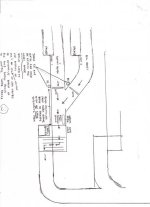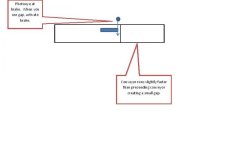In your Rockwell Automation Connected Components Workbench program, under "User Defined Function Blocks, under the Block instrtuction ("Instruction Block Selector"), is there any type of Bit-Shift Register in any of the listings? (It could be under "Data Manipulation").
If not, you will have to "roll your own" Bit-Shift Register, using memory storage locations. Okie (Paul) can help you with that! In other words, you will have to create a memory area that will simulate (virtually track in PLC memory) the physical movement of each box from the gates to the brake. Because these bits will shift when the boxes move, then the arrival of a bit at a certain memory location will signal the arrival of a certain-sized box at the brake.
Because you have only two different sizes of boxes, you can use only 1 Bit-Shift Register to simulate Big and Small boxes, because each bit can be two states, 0 or 1. Just decide which you want to represent each size, and find a memory file type and area where you have enough free bits to represent the physical distance from the gates to the brake. You will need to find out how fast the bits will move, and how many bits will be needed to represent in PLC memory the maximum physical BIG-box positions between the two end points (marked "BOXES ACCUMULATE" on your sketch). This is the maximum number of boxes of any size, that should be allowed on the conveyor between the gates and the brake. That will allow your bit-shift to work correctly. If it turns out that all the boxes are small, then that is okay, as long as there are quantity allowed on the belt than the maximum number of large boxes that will fit in the same space. The reason is that your bit-shift register is going to have a constant number of spaces, between the Entry Point and the Exit point, and you must prevent the number of boxes, in the same physical space, from ever being more than that number.
Your simulated Shift Register should be triggered each time a box leaves the brake. At the same time, a new box is fed in at one of the two gates, and a 1 or 0 bit is inserted into memory to represent the box size. At the brake, as a known box size arrives (based on the bit being shifted to that position), the correct brake time is triggered, and the box is passed, which triggers the next gate release and also the 1-or-0 bit insertion, and then a bit shift that moves each bit 1 position toward the Exit Bit (Brake Position).







